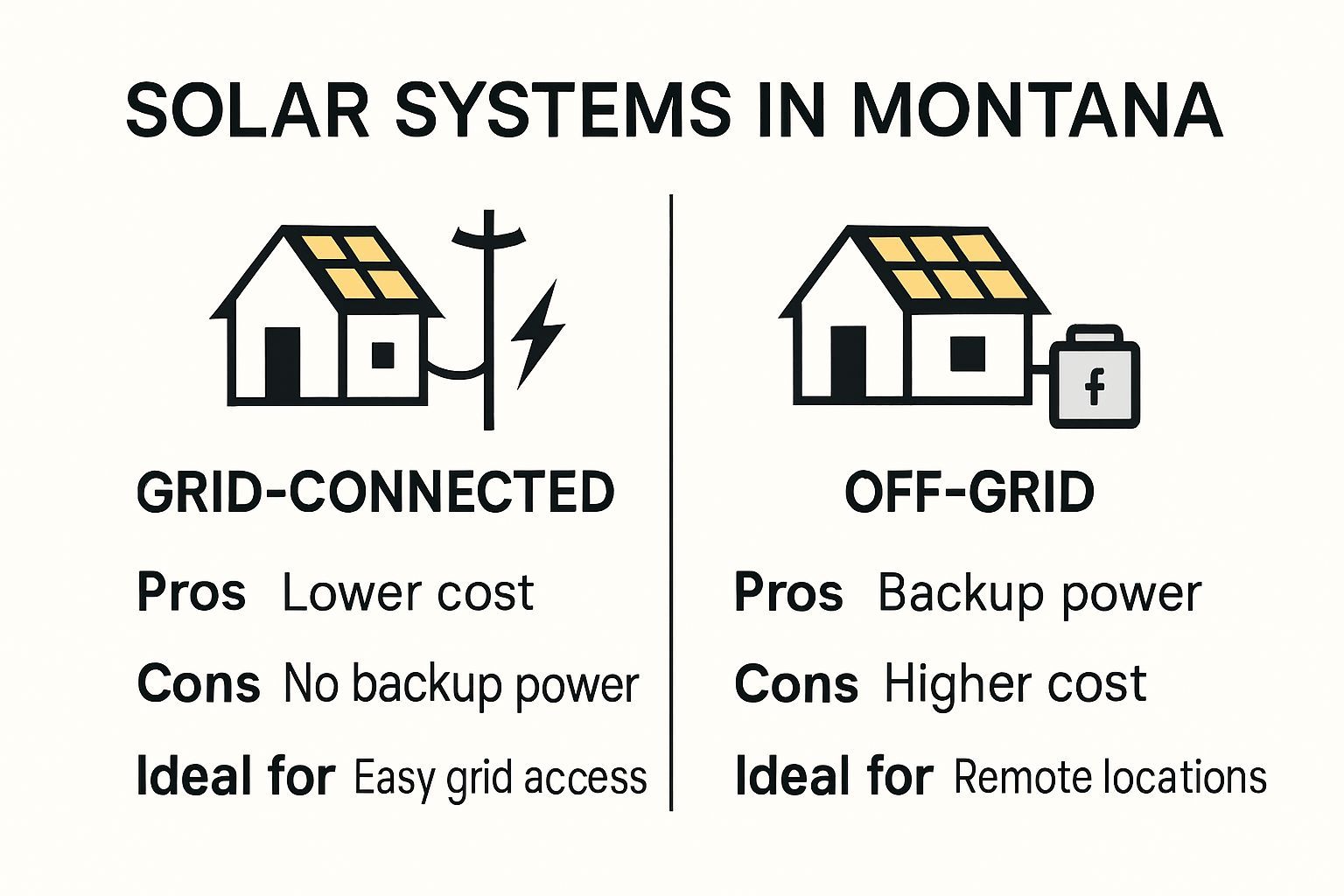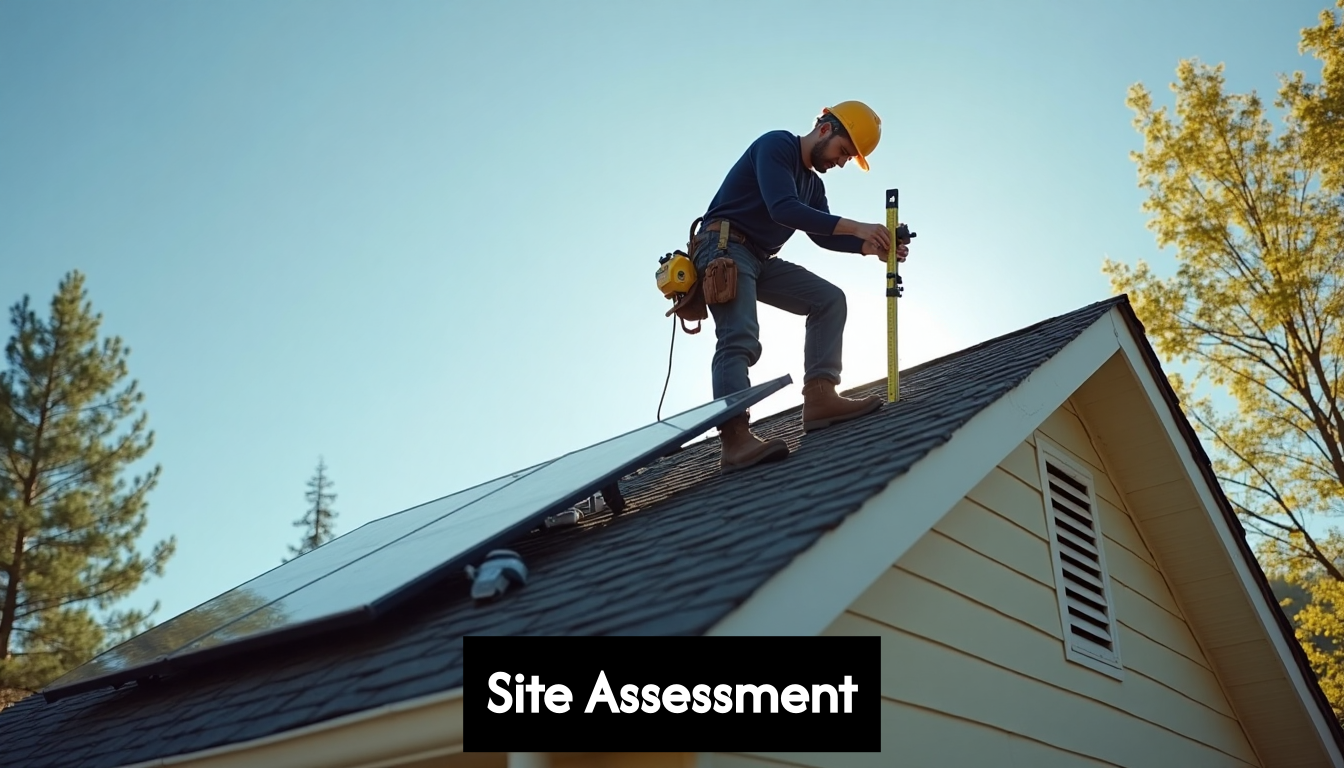Solar System Installation Process in Montana: 2025 Guide
Contact Us

Solar installation in Montana is picking up speed, with a typical 12.6 kW solar system now covering up to 92 percent of a household’s annual energy use. That sounds massive for homeowners looking to cut costs. Oddly though, it’s not just about the panels or even the power savings. The biggest surprise? The real challenge is navigating the complex web of permits, incentives, and regulations Montana throws your way. Here’s where most people get tripped up.
Table of Contents
- Understanding Solar System Options In Montana
- Grid Connected Vs Off Grid Solar Systems
- System Size And Energy Production Considerations
- Financial Incentives And System Selection
- Step-By-Step Solar Installation Process Explained
- Initial Site Assessment And System Design
- Permitting And Utility Approval Process
- Physical Installation And System Activation
- Permits, Incentives, And Local Regulations In Montana
- Electrical And Building Permit Requirements
- Solar Incentives And Financial Benefits
- Net Metering And Grid Interconnection Policies
- Maximizing Benefits For Montana's Diverse Communities
- Rural And Agricultural Community Solar Solutions
- Financial Accessibility And Incentive Structures
- Community And Nonprofit Solar Initiatives
Quick Summary
| Takeaway | Explaination |
|---|---|
| Grid Connected Vs Off Grid | Homeowners in Montana can choose between grid connected systems, which allow for net metering, and off grid systems for energy independence in remote areas. |
| Incentives and Financial Benefits | Montana offers multiple financial incentives, including federal tax credits and state exemptions, to significantly reduce installation costs for solar systems. |
| Step-by-Step Installation Process | The solar installation process involves a thorough site assessment, obtaining necessary permits, and conducting a physical installation, all of which require professional expertise to ensure compliance with local regulations. |
| Community Engagement | Community and nonprofit solar initiatives are emerging, enabling collective solar investments that can help underserved populations access renewable energy solutions. |
| Maximizing Energy Production | Proper system sizing based on energy needs and local solar potential can enable homeowners to significantly offset their electric bills, with a typical 12.6 kW system covering up to 92% of household energy use. |
Understanding Solar System Options in Montana
Montana's diverse landscape and unique energy requirements demand a strategic approach to solar system selection. Homeowners and businesses seeking renewable energy solutions must carefully evaluate their specific needs, location characteristics, and available solar technologies to maximize efficiency and return on investment.
Grid Connected vs Off Grid Solar Systems
In Montana, solar system installation offers two primary configurations that cater to different energy needs and property characteristics. Grid connected solar systems provide seamless integration with existing electrical infrastructure, allowing property owners to draw power from the grid when solar production is insufficient. According to Montana Renewable Energy Association, these systems are ideal for properties with consistent utility access and enable net metering, where excess electricity can be credited back to the homeowner.
Conversely, off grid solar systems represent a comprehensive solution for remote Montana properties lacking reliable electrical infrastructure. These standalone systems require comprehensive battery storage and typically include larger solar arrays to ensure consistent power generation. Rural property owners in mountainous or isolated regions often find off grid systems more practical, providing energy independence and resilience against utility disruptions.

System Size and Energy Production Considerations
Determining the appropriate solar system size requires careful analysis of energy consumption patterns and regional solar potential. Energy Sage research suggests that Montana homeowners typically need a 12.6 kW solar panel system to fully offset their average electric bill. This system configuration can potentially cover approximately 92% of household electricity needs, representing a significant long term investment in renewable energy.
Factors influencing solar system sizing include:
- Annual electricity consumption: Detailed review of past utility bills
- Roof or ground installation area: Available space for solar panel placement
- Local solar irradiance: Montana's specific sunlight exposure patterns
- Energy efficiency of existing appliances and home infrastructure
Financial Incentives and System Selection
Montana residents benefit from multiple financial incentives that can significantly reduce solar system installation costs. The federal solar investment tax credit (ITC) provides substantial upfront savings, while the state's Renewable Energy Systems Exemption offers additional financial advantages. EcoWatch research highlights these incentives as critical considerations when selecting solar system options.
Property owners should conduct comprehensive assessments considering system performance, installation costs, available incentives, and long term energy savings. Professional solar consultations can provide personalized recommendations tailored to individual energy requirements, property characteristics, and financial goals.
By understanding these nuanced solar system options, Montana residents can make informed decisions that balance technological capabilities, financial considerations, and environmental sustainability.
Step-by-Step Solar Installation Process Explained
The solar system installation process in Montana requires meticulous planning, precision, and adherence to local regulations. Homeowners embarking on this renewable energy journey must understand the comprehensive steps involved to ensure a successful and efficient solar panel deployment.
Initial Site Assessment and System Design
Before any physical installation begins, a thorough site evaluation is crucial. According to Yellowball Solar, professionals conduct an extensive assessment focusing on critical factors that determine solar system viability. Roof suitability becomes the primary consideration, examining aspects such as:
- Roof orientation: Ideal south-facing placement with a 15°-40° slope
- Roof condition: Minimum 10-15 years of remaining structural integrity
- Shading analysis: Minimal obstruction from trees or surrounding structures

Engineers develop a customized system design that maximizes energy production while considering the unique characteristics of the Montana property. This design phase includes precise calculations of energy requirements, panel placement, and potential electricity generation based on local solar irradiance.
Permitting and Utility Approval Process
Navigating the administrative requirements is a critical step in the solar installation process. Palmetto Solar outlines a comprehensive approach to securing necessary approvals. Installers must obtain:
- Local building permits
- Electrical permits
- Utility interconnection agreements
- Compliance documentation for state and federal regulations
Montana property owners should anticipate this phase taking several weeks, as local authorities carefully review technical specifications, structural integrity, and electrical system compatibility. The complexity of this process underscores the importance of working with experienced local solar installation professionals who understand regional requirements.
Physical Installation and System Activation
The actual solar system installation represents the culmination of careful planning. Professional installation teams typically complete the physical setup within one to two days, involving:
- Mounting hardware installation
- Solar panel placement
- Electrical system integration
- Inverter and battery storage setup (if applicable)
Following physical installation, a critical final step involves comprehensive system inspections. Professional solar experts require approval from two key entities:
- Local authority having jurisdiction (AHJ)
- Electric utility company
Only after receiving official Permission to Operate (PTO) can the solar system be fully interconnected and begin generating electricity. This rigorous verification process ensures system safety, performance, and compliance with all technical standards.
Montana homeowners should view the solar installation process as a comprehensive journey requiring patience, professional expertise, and careful attention to detail. By understanding each step, property owners can confidently navigate the transition to renewable energy, maximizing both environmental benefits and long-term energy savings.
Permits, Incentives, and Local Regulations in Montana
Navigating the solar installation landscape in Montana requires a comprehensive understanding of permits, incentives, and local regulations. Property owners must carefully manage these administrative requirements to ensure a smooth and legally compliant solar system deployment.
Electrical and Building Permit Requirements
Montana has specific regulatory frameworks governing solar installations. According to the Montana Department of Environmental Quality, electrical permits are mandatory for all residential solar photovoltaic (PV) systems. Commercial solar installations in Montana demand additional complexity, requiring a licensed electrical contractor to obtain appropriate permits.
Permit requirements typically involve:
- Detailed system design documentation
- Electrical system specifications
- Structural assessment of installation location
- Proof of compliance with local building codes
The permit fees are calculated based on the total value of electrical work, including solar system components. Property owners should anticipate varying requirements across different Montana jurisdictions, emphasizing the importance of working with local solar professionals familiar with regional regulations.
Solar Incentives and Financial Benefits
Montana offers several financial incentives to encourage solar adoption. The federal solar investment tax credit remains a primary mechanism for reducing installation costs. Montana Building Codes and Permits Division highlights additional state-level benefits that make solar investments more attractive.
Key financial incentives include:
- Federal Solar Investment Tax Credit: Significant percentage reduction of installation costs
- Net Metering Programs: Credits for excess electricity returned to the grid
- Property Tax Exemptions: Potential reduction in property tax assessments for solar installations
- Renewable Energy Systems Exemption: Additional financial relief for solar adopters
Net Metering and Grid Interconnection Policies
Net metering represents a critical component of Montana's solar regulatory environment. State energy reports indicate that utility companies provide credits for excess energy generated by residential and commercial solar systems. However, credit rates and specific terms vary among different utility providers.
Additionally, Montana is poised to introduce community solar legislation in 2025. PV Magazine reports upcoming changes that will enable solar developers to create arrays between 50 kW and 5 MW. This legislation will provide unprecedented opportunities for renters and individuals unable to install rooftop solar, including options to assign credits to nonprofits or low-income energy programs.
Successful solar system installation in Montana demands a strategic approach that balances technical requirements, financial considerations, and regulatory compliance. Property owners should collaborate with experienced local solar professionals who can effectively navigate these complex administrative landscapes, ensuring a smooth transition to renewable energy.
By understanding these intricate permit processes, financial incentives, and evolving regulations, Montana residents can make informed decisions that maximize their solar investment while contributing to the state's sustainable energy future.
Maximizing Benefits for Montana's Diverse Communities
Solar energy represents more than a technological advancement in Montana—it is a transformative opportunity for diverse communities to achieve energy independence, economic resilience, and environmental sustainability. Understanding how different population segments can leverage solar technologies becomes crucial in creating an inclusive renewable energy landscape.
Rural and Agricultural Community Solar Solutions
Montana's expansive rural regions present unique challenges and opportunities for solar adoption. EcoWatch research highlights that net metering policies enable rural property owners to offset or eliminate electric bills by sending excess energy back to the grid. Agricultural installations can particularly benefit from solar technologies, transforming traditional energy consumption models.
Key advantages for rural communities include:
- Energy cost stabilization: Predictable electricity expenses
- Agricultural productivity enhancement: Powering irrigation systems and farm equipment
- Land utilization: Converting unused acreage into energy generation sites
- Economic diversification: Creating additional revenue streams through energy production
Financial Accessibility and Incentive Structures
Financial barriers often prevent widespread solar adoption, but Montana offers comprehensive incentive structures designed to improve accessibility. According to federal tax credit guidelines, the Investment Tax Credit provides a substantial 30% credit on total solar system expenses, which in Montana averages around $8,694.
Additionally, the state's Renewable Energy Systems Exemption prevents property tax increases resulting from solar installations. This policy ensures that homeowners across different socioeconomic backgrounds can adopt solar technologies without facing additional financial burdens. Specific benefits include:
- No property tax increases for solar system installations
- Reduced upfront costs through federal tax credits
- Long-term energy savings
- Increased property values
Community and Nonprofit Solar Initiatives
Montana is witnessing a transformative approach to solar energy through community and nonprofit engagement. Emerging legislative frameworks are creating pathways for collaborative solar projects that extend benefits beyond individual property ownership.
Innovative approaches include:
- Community solar projects: Enabling collective solar investments
- Nonprofit energy programs: Facilitating solar access for underserved populations
- Educational institution solar installations: Demonstrating renewable energy potential
- Low-income housing solar integration: Reducing energy costs for vulnerable communities
These initiatives represent more than technological implementations—they are strategic investments in Montana's social and economic resilience. By democratizing solar access, communities can collectively address energy challenges, reduce carbon footprints, and create more sustainable local economies.
Maximizing solar benefits requires a holistic approach that considers technological capabilities, financial mechanisms, and community-specific needs. Montana's diverse populations stand to gain significant advantages by embracing solar technologies with thoughtful, inclusive strategies that recognize the unique characteristics of different community segments.
Frequently Asked Questions
What are the steps involved in the solar system installation process in Montana?
The solar installation process in Montana includes an initial site assessment, securing necessary permits, obtaining utility approval, physical installation of the system, and final inspections before activation.
What types of solar systems are available for homeowners in Montana?
Homeowners in Montana can choose between grid-connected solar systems that allow for net metering and off-grid solar systems that provide energy independence, especially in remote areas.
What financial incentives are available for solar installation in Montana?
Montana offers several financial incentives, including the federal solar investment tax credit, state property tax exemptions, and net metering programs, which can significantly reduce the upfront costs of solar systems.
How does net metering work in Montana for solar energy users?
Net metering in Montana allows homeowners with solar systems to receive credits for excess energy generated and sent back to the grid, effectively reducing their electricity bills based on the amount of energy produced.
Ready for a Hassle-Free Solar Journey in Montana?
Navigating the maze of permits, incentives, and local rules can feel overwhelming, especially when all you want is a reliable solar system that fits your needs. The article highlighted how tricky it is to balance grid-connected vs off-grid options, maximize incentives, and ensure your project gets the green light the first time. If you want to avoid the usual pitfalls and truly make the most of Montana’s solar potential, personalized guidance is key. Our team at Ellingson Roofing LLC is dedicated to making the process easy for you, from the first assessment to the final inspection. We specialize in helping Montana homeowners, businesses, and nonprofits gain energy independence and savings, making sure you benefit from every available incentive and regulatory update.
Why wait and risk missing out on 2025’s incentives or the newest net metering changes? Get expert help tailored to Montana’s unique landscape and your specific energy goals. Visit Ellingson Roofing LLC now to request your free estimate or reach out for a one-on-one consultation. Take the first step today and feel confident your solar project will be done right from start to finish.





